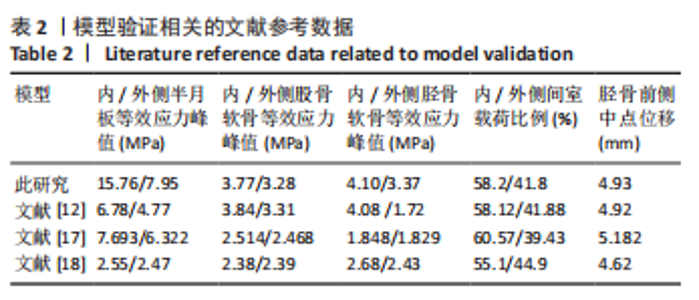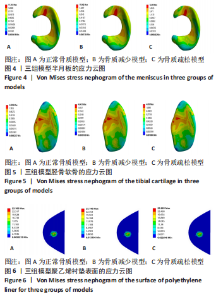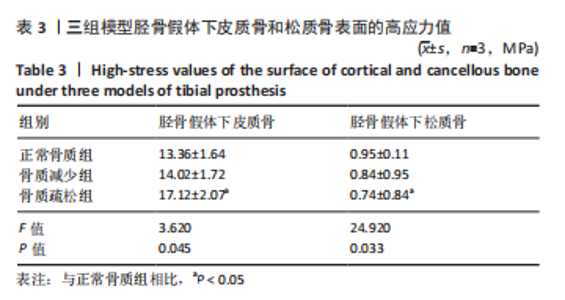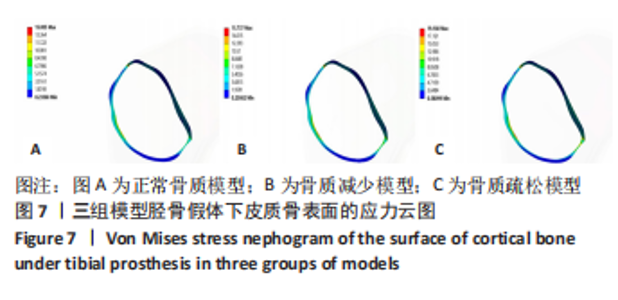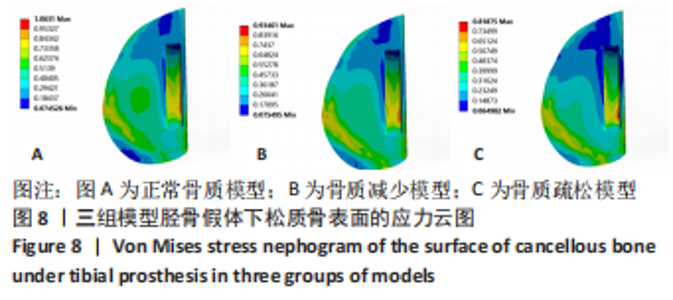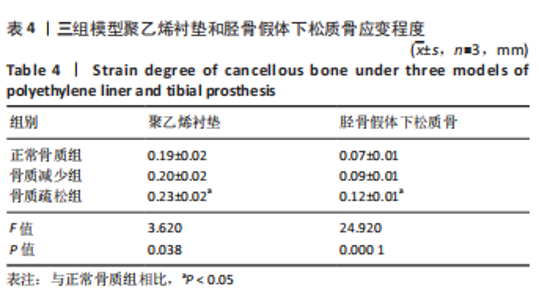Chinese Journal of Tissue Engineering Research ›› 2024, Vol. 28 ›› Issue (24): 3801-3806.doi: 10.12307/2024.613
Previous Articles Next Articles
Three-dimensional finite element analysis of effects of different bone densities on various intraarticular structures after unicompartmental knee arthroplasty
Liu Mengfei1, Ma Pengcheng2, Yin Can1, Jiang Kan1, Ju Xiaochen1
- 1Department of Joint Surgery, Sixth Affiliated Hospital of Xinjiang Medical University, Urumqi 830000, Xinjiang Uygur Autonomous Region, China; 2Department of Orthopedics, Shandong Public Health Clinical Center, Jinan 250000, Shandong Province, China
-
Received:2023-06-26Accepted:2023-08-09Online:2024-08-28Published:2023-11-20 -
Contact:Ju Xiaochen, Associate chief physician, Department of Joint Surgery, Sixth Affiliated Hospital of Xinjiang Medical University, Urumqi 830000, Xinjiang Uygur Autonomous Region, China -
About author:Liu Mengfei, Master candidate, Department of Joint Surgery, Sixth Affiliated Hospital of Xinjiang Medical University, Urumqi 830000, Xinjiang Uygur Autonomous Region, China Ma Pengcheng, Master, Physician, Department of Orthopedics, Shandong Public Health Clinical Center, Jinan 250000, Shandong Province, China
CLC Number:
Cite this article
Liu Mengfei, Ma Pengcheng, Yin Can, Jiang Kan, Ju Xiaochen. Three-dimensional finite element analysis of effects of different bone densities on various intraarticular structures after unicompartmental knee arthroplasty[J]. Chinese Journal of Tissue Engineering Research, 2024, 28(24): 3801-3806.
share this article
Add to citation manager EndNote|Reference Manager|ProCite|BibTeX|RefWorks
| [1] GBD 2015 Disease and Injury Incidence and Prevalence Collaborators. Global, regional, and national incidence, prevalence, and years lived with disability for 310 diseases and injuries, 1990-2015: a systematic analysis for the Global Burden of Disease Study 2015. Lancet. 2016;388(10053):1545-1602. [2] PRIMORAC D, MOLNAR V, ROD E, et al. Knee Osteoarthritis: A Review of Pathogenesis and State-Of-The-Art Non-Operative Therapeutic Considerations. Genes (Basel). 2020;11(8):854. [3] BONANO JC, BARRETT AA, AMANATULLAH DF. Medial Unicompartmental Knee Arthroplasty with a Mobile-Bearing Implant. JBJS Essent Surg Tech. 2021;11(2): e20.00002. [4] LUNEBOURG A, PARRATTE S, OLLIVIER M, et al. Are Revisions of Unicompartmental Knee Arthroplasties More Like a Primary or Revision TKA? J Arthroplasty. 2015;30(11):1985-1989. [5] 林华,包丽华.骨质疏松性骨折的骨损害[J].中华医学杂志,2022,102(13): 903-907. [6] CONLISK N, HOWIE CR, PANKAJ P. Optimum stem length for mitigation of periprosthetic fracture risk following primary total knee arthroplasty: a finite element study. Knee Surg Sports Traumatol Arthrosc. 2018;26(5):1420-1428. [7] LEE DH, PADHY D, LEE SH, et al. Osteoporosis affects component positioning in computer navigation-assisted total knee arthroplasty. Knee. 2012;19(3):203-207. [8] HOUSKAMP DJ, TOMPANE T, BARLOW BT. What Is the Critical Tibial Resection Depth During Unicompartmental Knee Arthroplasty? A Biomechanical Study of Fracture Risk. J Arthroplasty. 2020;35(8):2244-2248. [9] ZHANG ZH, QI YS, WEI BG, et al. Application strategy of finite element analysis in artificial knee arthroplasty. Front Bioeng Biotechnol. 2023;11:1127289. [10] GHEORGHIU N, SOCEA B, DIMITRIU MCT, et al. A finite element analysis for predicting outcomes of cemented total knee arthroplasty. Exp Ther Med. 2021; 21(3):267. [11] 张吉超,董万鹏,董跃福,等.膝关节有限元模型参数设置[J].中国组织工程研究,2021,25(30):4781-4786. [12] 马鹏程,张思平,孙荣鑫,等.单髁置换股骨假体不同放置位置的生物力学效应[J].中国组织工程研究,2022,26(12):1843-1848. [13] KANG KT, KWON OR, SON J, et al. Effect of joint line preservation on mobile-type bearing unicompartmental knee arthroplasty: finite element analysis. Australas Phys Eng Sci Med. 2018;41(1):201-208. [14] NIE Y, YU Q, SHEN B. Impact of Tibial Component Coronal Alignment on Knee Joint Biomechanics Following Fixed-bearing Unicompartmental Knee Arthroplasty: A Finite Element Analysis. Orthop Surg. 2021;13(4):1423-1429. [15] HOPKINS AR, NEW AM, RODRIGUEZ-Y-BAENA F, et al. Finite element analysis of unicompartmental knee arthroplasty. Med Eng Phys. 2010;32(1):14-21. [16] INNOCENTI B, PIANIGIANI S, RAMUNDO G, et al. Biomechanical Effects of Different Varus and Valgus Alignments in Medial Unicompartmental Knee Arthroplasty. J Arthroplasty. 2016;31(12):2685-2691. [17] 李钟鑫.膝关节单间室假体置换的生物力学研究[D].天津:天津理工大学, 2021. [18] 朱广铎,郭万首,程立明,等.活动平台单髁膝关节置换胫骨后倾的有限元分析[J].中国组织工程研究,2015,19(44):7156-7162. [19] BAO HR, ZHU D, GONG H, et al. The effect of complete radial lateral meniscus posterior root tear on the knee contact mechanics: a finite element analysis. J Orthop Sci. 2013;18(2):256-263. [20] 范熹微,聂涌,吴元刚,等.膝关节内侧固定平台单髁假体放置位置优化的有限元分析[J].中华骨科杂志,2020,40(3):169-177. [21] INOUE S, AKAGI M, ASADA S, et al. The Valgus Inclination of the Tibial Component Increases the Risk of Medial Tibial Condylar Fractures in Unicompartmental Knee Arthroplasty. J Arthroplasty. 2016;31(9):2025-2030. [22] WANG Z, MA R, CAI Z, et al. Biomechanical Evaluation of Stand-Alone Oblique Lateral Lumbar Interbody Fusion Under 3 Different Bone Mineral Density Conditions: A Finite Element Analysis. World Neurosurg. 2021;155:e285-e293. [23] POLIKEIT A, NOLTE LP, FERGUSON SJ. The effect of cement augmentation on the load transfer in an osteoporotic functional spinal unit: finite-element analysis. Spine (Phila Pa 1976). 2003;28(10):991-996. [24] THOREAU L, MORCILLO MARFIL D, et al. Periprosthetic fractures after medial unicompartmental knee arthroplasty: a narrative review. Arch Orthop Trauma Surg. 2022;142(8):2039-2048. [25] MUSBAHI O, HAMILTON TW, CRELLIN AJ, et al. The effect of obesity on revision rate in unicompartmental knee arthroplasty: a systematic review and meta-analysis. Knee Surg Sports Traumatol Arthrosc. 2021;29(10):3467-3477. [26] KWON HM, LEE JA, KOH YG, et al. Computational analysis of tibial slope adjustment with fixed-bearing medial unicompartmental knee arthroplasty in ACL- and PCL-deficient models. Bone Joint Res. 2022;11(7):494-502. [27] XIONG H, ZENG Y, SI H, et al. Research progress on finite element analysis of unicompartmental knee arthroplasty in medial knee compartmental osteoarthritis. Zhongguo Xiu Fu Chong Jian Wai Ke Za Zhi. 2021;35(6):781-785. [28] APOSTOLOPOULOS V, TOMÁŠ T, BOHÁČ P, et al. Biomechanical analysis of all-polyethylene total knee arthroplasty on periprosthetic tibia using the finite element method. Comput Methods Programs Biomed. 2022;220:106834. [29] 屈亚飞,袁霄,肖娜.单间室膝关节活动式假体优化设计有限元分析[J].技术与市场,2023,30(3):30-32. [30] PARK DY, MIN BH, KIM DW, et al. Polyethylene wear particles play a role in development of osteoarthritis via detrimental effects on cartilage, meniscus, and synovium. Osteoarthritis Cartilage. 2013;21(12):2021-2029. [31] KWON OR, KANG KT, SON J, et al. Importance of joint line preservation in unicompartmental knee arthroplasty: Finite element analysis. J Orthop Res. 2017;35(2):347-352. [32] ZHAO M, GUO Y, WANG C, et al. Finite element analysis of the effect of knee movable unicompartmental prosthesis insertion shape and mounting position on stress distribution in the knee joint after replacement. Sheng Wu Yi Xue Gong Cheng Xue Za Zhi. 2022;39(4):660-671. [33] INNOCENTI B, BILGEN ÖF, LABEY L, et al. Load sharing and ligament strains in balanced, overstuffed and understuffed UKA. A validated finite element analysis. J Arthroplasty. 2014;29(7):1491-1498. [34] KANG KT, KIM SH, SON J, et al. Probabilistic evaluation of the material properties of the in vivo subject-specific articular surface using a computational model. J Biomed Mater Res B Appl Biomater. 2017;105(6):1390-1400. [35] HAUT DONAHUE TL, HULL ML, RASHID MM, et al. How the stiffness of meniscal attachments and meniscal material properties affect tibio-femoral contact pressure computed using a validated finite element model of the human knee joint. J Biomech. 2003;36(1):19-34. |
| [1] | Li Zhifei, Yang Yin, Chen Hualong, Liang Qinqiu, Zhong Yuanming, Zhang Yisheng. Finite element analysis of the correlation between tilt angle of titanium cage and postoperative subsidence of titanium cage after anterior subtotal cervical corpectomy, decompression and fusion [J]. Chinese Journal of Tissue Engineering Research, 2024, 28(9): 1313-1319. |
| [2] | Chen Mengmeng, Bao Li, Chen Hao, Jia Pu, Feng Fei, Shi Guan, Tang Hai. Biomechanical characteristics of a novel interspinous distraction fusion device BacFuse for the repair of lumbar degenerative disease [J]. Chinese Journal of Tissue Engineering Research, 2024, 28(9): 1325-1329. |
| [3] | Liang Cheng, Zhang Linqi, Wang Guan, Li Wen, Duan Ke, Li Zhong, Lu Xiaobo, Zhuo Naiqiang. Finite element and biomechanical analysis of different implants in repair for unilateral unstable pelvic posterior ring injury [J]. Chinese Journal of Tissue Engineering Research, 2024, 28(9): 1336-1341. |
| [4] | Guo Sutong, Feng Dehong, Guo Yu, Wang Ling, Ding Yujian, Liu Yi, Qian Zhengying, Li Mingyang. Construction and finite element analysis of normal and osteoporotic hip models [J]. Chinese Journal of Tissue Engineering Research, 2024, 28(9): 1342-1346. |
| [5] | Yang Junliang, Lu Tan, Xu Biao, Jiang Yaqiong, Wang Fucheng. Three-dimensional finite element analysis of effects of partial anterior cruciate ligament rupture on knee joint stress [J]. Chinese Journal of Tissue Engineering Research, 2024, 28(9): 1347-1353. |
| [6] | Li Yongjie, Fu Shenyu, Xia Yuan, Zhang Dakuan, Liu Hongju. Correlation of knee extensor muscle strength and spatiotemporal gait parameters with peak knee flexion/adduction moment in female patients with knee osteoarthritis [J]. Chinese Journal of Tissue Engineering Research, 2024, 28(9): 1354-1358. |
| [7] | Min Meipeng, Wu Jin, URBA RAFI, Zhang Wenjie, Gao Jia, Wang Yunhua, He Bin, Fan Lei. Role and significance of artificial intelligence preoperative planning in total hip arthroplasty [J]. Chinese Journal of Tissue Engineering Research, 2024, 28(9): 1372-1377. |
| [8] | Shan Jiaxin, Zhang Yilong, Wu Hongtao, Zhang Jiayuan, Li Anan, Liu Wengang, Xu Xuemeng, Zhao Chuanxi. Changes in muscle strength and pain in patients receiving Jianpi Yiqi Huoxue Formula after total knee arthroplasty [J]. Chinese Journal of Tissue Engineering Research, 2024, 28(9): 1378-1382. |
| [9] | Qi Haodong, Lu Chao, Xu Hanbo, Wang Mengfei, Hao Yangquan. Effect of diabetes mellitus on perioperative blood loss and pain after primary total knee arthroplasty [J]. Chinese Journal of Tissue Engineering Research, 2024, 28(9): 1383-1387. |
| [10] | Li Xiaoqiang, Chen Wei, Li Mingyue, Shan Tianchi, Shen Wen. Value of preoperative quantitative ultrasound analysis of quadriceps femoris in predicting chronic post-surgical pain after total knee arthroplasty [J]. Chinese Journal of Tissue Engineering Research, 2024, 28(9): 1388-1393. |
| [11] | Du Changling, Shi Hui, Zhang Shoutao, Meng Tao, Liu Dong, Li Jian, Cao Heng, Xu Chuang. Efficacy and safety of different applications of tranexamic acid in high tibial osteotomy [J]. Chinese Journal of Tissue Engineering Research, 2024, 28(9): 1409-1413. |
| [12] | Weng Rui, Lin Dongxin, Guo Haiwei, Zhang Wensheng, Song Yuke, Lin Hongheng, Li Wenchao, Ye Linqiang. Abnormal types of intervertebral disc structure and related mechanical loading with biomechanical factors [J]. Chinese Journal of Tissue Engineering Research, 2024, 28(9): 1436-1442. |
| [13] | Xiaheida·Yilaerjiang, Nijiati·Tuerxun, Reyila·Kuerban, Baibujiafu·Yelisi, Chen Xin. Three-dimensional finite element analysis of the distribution pattern of stress in bone tissues with different characteristics [J]. Chinese Journal of Tissue Engineering Research, 2024, 28(8): 1277-1282. |
| [14] | Zhang Xiaoyun, Liu Hua, Chai Yuan, Chen Feng, Zeng Hao, Gao Zhengang, Huang Yourong. Effect of Yishen Gushu Formula on bone metabolic markers and clinical efficacyn in patients with osteoporosis of kidney deficiency and blood stasis type [J]. Chinese Journal of Tissue Engineering Research, 2024, 28(8): 1155-1160. |
| [15] | Huang Xiarong, Hu Lizhi, Sun Guanghua, Peng Xinke, Liao Ying, Liao Yuan, Liu Jing, Yin Linwei, Zhong Peirui, Peng Ting, Zhou Jun, Qu Mengjian. Effect of electroacupuncture on the expression of P53 and P21 in articular cartilage and subchondral bone of aged rats with knee osteoarthritis [J]. Chinese Journal of Tissue Engineering Research, 2024, 28(8): 1174-1179. |
| Viewed | ||||||
|
Full text |
|
|||||
|
Abstract |
|
|||||
